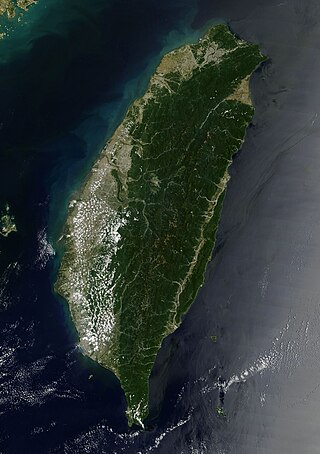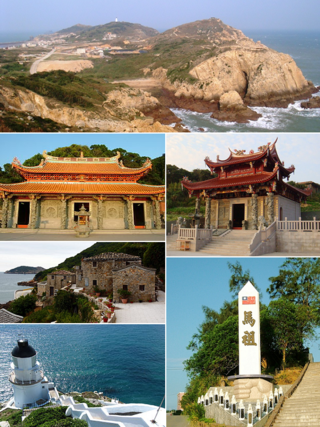
Taiwan, officially the Republic of China (ROC), is an island country in East Asia. The island of Taiwan, formerly known as Formosa, makes up 99% of the land area of the territories under ROC control. The main island is 35,808 square kilometres (13,826 sq mi) and lies some 180 kilometres (112 mi) across the Taiwan Strait from the southeastern coast of the People's Republic of China (PRC). The East China Sea lies to the north of the island, the Philippine Sea to its east, the Luzon Strait directly to its south and the South China Sea to its southwest. The ROC also controls a number of smaller islands, including the Penghu archipelago in the Taiwan Strait, the Kinmen and Matsu Islands in Fuchien near the PRC's coast, and some of the South China Sea Islands.

Xiamen is a sub-provincial city in southeastern Fujian, People's Republic of China, beside the Taiwan Strait. It is divided into six districts: Huli, Siming, Jimei, Tong'an, Haicang, and Xiang'an. All together, these cover an area of 1,700.61 square kilometers (656.61 sq mi) with a population of 5,163,970 as of 2020 and estimated at 5.308 million as of 31 December 2022. The urbanized area of the city has spread from its original island to include most parts of all six of its districts, as well as 4 Zhangzhou districts, which form a built-up area of 7,284,148 inhabitants. This area also connects with Quanzhou in the north, making up a metropolis of nearly ten million people. The Kinmen Islands (Quemoy) administered by the Republic of China (Taiwan) lie less than 6 kilometers (4 mi) away separated by Xiamen Bay. As part of the Opening Up Policy under Deng Xiaoping, Xiamen became one of China's original four special economic zones opened to foreign investment and trade in the early 1980s.

Kinmen, alternatively known as Quemoy, is a group of islands governed as a county by the Republic of China (Taiwan), only 10 km (6.2 mi) east from the city of Xiamen in Fujian, located at the southeastern coast of the People's Republic of China, from which they are separated by Xiamen Bay. Kinmen is also located 187 km (116 mi) west from the closest shoreline of the island of Taiwan across the Taiwan Strait.

The Matsu Islands, officially Lienchiang County, are an archipelago of 36 islands and islets in the East China Sea governed by the Republic of China (Taiwan), situated alongside the southeastern coast of mainland China. The archipelago forms the smallest county in the ROC-controlled territories by area and population, as well as one of two counties that is a part of the nominal Fuchien Province.

Sun Yat-sen's Mausoleum is situated at the foot of the second peak of Purple Mountain in Nanjing, China. Construction of the tomb started in January 1926, and was finished in spring of 1929. The architect was Lü Yanzhi, who died shortly after it was finished. His representative and project partner was his close friend Huang Tanpu.

Jincheng Township is an urban township on the southwestern corner of the island of Kinmen (Quemoy). It is the county seat of Kinmen County, Fujian Province, Republic of China (Taiwan). Jincheng was the seat of the ROC's Fukien Province from 1949–1956 and 1996–2018. In March 2012, it was named one of the Top 10 Small Tourist Towns by the Tourism Bureau.

The Kinmen National Park is a national park in Kinmen, Fuchien Province, Republic of China.

The Guningtou Battle Museum is located in the Kuningtou area of the Kinmen National Park, Jinning Township, Kinmen County, Taiwan.

Dadan Island is an island in Lieyu Township, Kinmen County, Fujian Province, Republic of China (Taiwan). The island is in the Taiwan Strait, along the coast of Mainland China. It is located approximately 12,000 m (7.5 mi) to the southwest of Lesser Kinmen (Lieyu) and approximately 4,400 m (2.7 mi) from Xiamen (Amoy).

The 1987 Lieyu massacre occurred on 7 March 1987 at Donggang Bay, Lieyu Island, Kinmen, Fujian, Republic of China (ROC). ROC military officially denied the massacre and defined it as an incident of "mistaken killings" (誤殺事件), hence named it the March 7 Incident (三七事件) or Donggang Incident (東崗事件). There may have been more than nineteen deaths, including several families of ethnic Chinese Vietnamese.

The Beihai Tunnel is a tunnel in Nangan Township, Lienchiang County, Taiwan. It is located between the villages of Ren-ai and Meishi. The tunnel runs from Tieban Coast deep into the heart of the hills in lattice shape.

The Beihai Tunnel is a tunnel in Banli village, Beigan Township, Lienchiang County, Taiwan.

The Wuqiu Lighthouse is a lighthouse in Daqiu Village, Wuqiu Township (Ockseu), Kinmen County (Quemoy), Fujian Province (Fukien), Republic of China (Taiwan).

The Dahan Stronghold is a former fort in Nangan Township, Lienchiang County, Taiwan.

The Jiugong Tunnel or Siwei Tunnel is a tunnel in Lieyu Township, Kinmen County, Taiwan. It was used during the 1958 Second Taiwan Strait Crisis, when the island was heavily shelled by People's Republic of China. Supplies and equipment from larger ocean going ships were brought in to shore by smaller vessels. They were unloaded in the tunnel safe from the bombardments.
The Min Ping Yu No. 5540 incident was a tragedy that occurred on July 21–22, 1990, when the Taiwan Garrison Command (TGC) forced 76 mainland Chinese illegal immigrants into sealed holds of a boat, causing 25 of them to die by suffocation in repatriating them from Taiwan to Fujian. 23 days after the incident, another mainland Chinese fishing boat, Min Ping Yu No. 5202, was hit by a Taiwanese naval destroyer escort in its repatriation operation, killing 21 of the 50 illegal immigrants on board.

The Beihai Tunnel is a tunnel in Dongyin Township, Lienchiang County, Taiwan.

The Chenggong Coastal Defense Tunnel is a tunnel in Jinhu, Kinmen County, Taiwan.

The Qingtian Hall is a hall in Jinhu Township, Kinmen County, Taiwan.


















